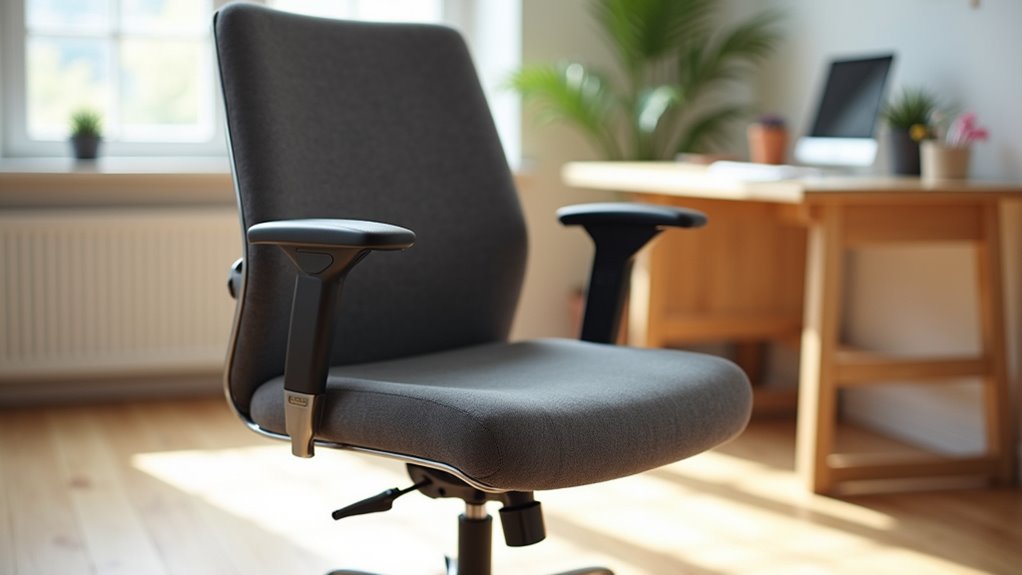How to Sit in the Office Chair
This post contains affiliate links. As an Amazon Associate, we earn from qualifying purchases.
To sit comfortably in your office chair, adjust the seat height so that your knees are just below your kneecaps when standing—ensuring your feet are flat on the floor, with no dangling. Next, ensure your back is supported by the lumbar support, creating a gentle hug for your spine. Your arms should rest comfortably on the desk, with elbows bent at 90 degrees. Lastly, make sure your feet are flat and not crossed. Further details and tips will follow to help enhance your sitting experience in the office.
Essential Facts in 30 Seconds
- Adjust seat height so knees are below kneecaps and feet are flat on the floor.
- Maintain a 2-4 inch gap between seat edge and back of knees for proper seat depth.
- Position lumbar support against the lower back to support spine’s natural curve.
- Keep armrests below elbows with arms bent at 90 degrees for relaxed shoulders.
- Ensure feet are flat on the floor or a footrest, with knees bent at 90 degrees.
Adjusting Seat Height for Comfort
Adjusting your office chair’s seat height is key for comfort.
Start by standing in front of the chair. Set the seat height just below your kneecaps.
Sit down and make sure your feet are flat on the floor. No dangling feet! Your hips and knees should be at a 90-degree angle. This helps keep your back happy and supported. Proper office ergonomics can also enhance your overall productivity and well-being. Additionally, it’s important to find a stable and comfortable height for optimal support. A chair with the correct height contributes to overall comfort and prevents discomfort and poor circulation. Make sure to evaluate your chair height regularly to ensure optimal comfort as your body position may change throughout the day.
If your toes can’t touch the ground, use a footrest. It will make your sitting experience much more comfortable.
Ensuring Proper Seat Depth and Thigh Support

Finding the right seat depth is very important for comfort and circulation. Start by sitting up straight. Make sure your back is fully supported.
Measure from the back of your hips to about two inches behind your knees. Aim for a gap of two to four inches between the seat’s edge and your knees. This gap should be about two or three fingers’ width. Adjustable seat depth is a key feature that allows for personalized comfort, ensuring that the chair fits your specific body dimensions. An appropriate seat depth helps maintain proper blood circulation and prevents strain on back and legs. Additionally, a chair that supports the natural curve of the spine can further enhance your sitting experience.
If your chair has adjustable sliders, use them! Slide the seat until you feel comfortable. You shouldn’t feel squished or cramped.
A well-fitted chair helps keep your thighs happy and blood flowing smoothly. Adjusting your seat properly makes a big difference in how you feel while sitting.
Utilizing Lumbar Support and Backrest Position
After adjusting your seat depth, focus on your lumbar support and backrest position.
First, set your lumbar support to fit snugly against your lower back. This helps keep your spine’s natural curve. It prevents slouching and back pain. Proper sitting posture is crucial for overall well-being. Additionally, maintaining proper back support reduces discomfort over time.
Next, adjust the backrest. It should support your back well as you sit upright. Aim for a position that feels comfortable, like a gentle hug for your spine. Proper lumbar support aligns the spine, reducing stress on spinal discs, which is essential for maintaining spinal alignment.
A properly adjusted backrest boosts blood circulation. This can help you stay focused and energized. Maintaining good posture while seated is vital for productivity.
Feeling sluggish? Check your lumbar support and backrest. They might be key to fighting fatigue. A happy back leads to a happier you!
Positioning Arms and Aligning With the Desk

Setting up your arms and desk correctly can greatly improve your comfort while working.
Start by adjusting your armrests. They should sit just below your elbows when your arms hang relaxed. Keep your elbows bent at about 90 degrees. This will help keep your shoulders relaxed and aligned, preventing tension. Proper height adjustment of your chair can also contribute to your overall comfort. Additionally, ensure that your chair and desk height are suitable for proper arm positioning to enhance comfort.
Keep your upper arms close to your body. Your forearms should rest comfortably at desk level. If your armrests aren’t fitting well, consider removing them. It’s better to avoid any strain or discomfort.
When everything lines up just right, you’ll feel a boost in comfort. Proper armrest positioning enhances overall comfort and helps prevent strain on your shoulders and neck.
Take a moment to adjust those armrests. Good posture will make a big difference. Your shoulders will feel the relief!
Maintaining Correct Foot Placement and Leg Position
Keep your feet comfy during work. Proper foot placement matters for comfort and leg alignment. Follow these tips for happy feet and legs:
- Feet flat: Rest your feet flat on the floor or a footrest.
- No dangling: Don’t let your feet dangle or cross. This can cut off circulation.
- Adjustments: Use a footrest if your feet can’t touch the floor. Proper chair adjustment is essential for maintaining good posture.
- Knees bent: Bend your knees to about 90 degrees for comfort.
- Check regularly: Look at your position often to make sure it feels good.
These simple steps make a big difference. Happy feet lead to a better workday! Regularly maintaining proper sitting posture can enhance your overall comfort.
Enjoy your time and say goodbye to discomfort!
Frequently Asked Questions
How Often Should I Take Breaks While Sitting?
Take breaks every 30 minutes to boost your productivity. Short breaks of 2-3 minutes help you move and reduce fatigue. Listen to your body. Adjust how often you take breaks based on how you feel. Staying active is important for your health. Regular breaks can make working easier and more enjoyable. Remember, small movements matter!
What Are the Signs of Poor Posture?
Signs of poor posture include slouching shoulders and neck strain. You might feel discomfort or tight muscles. Reduced motion can also happen. It’s important to fix your workspace. Pay attention to how you sit. Small changes can make a big difference. Check your screen height and chair support. Sit all the way back in your chair. Keep your feet flat on the floor. Take breaks to stretch. Good posture helps you feel better and work better.
Can I Use a Cushion for Extra Comfort?
Using cushions can boost your comfort level. They help reduce pressure points while sitting. This can make a big difference during long hours at your desk. Cushions support good posture, which is important for your back. Different types of cushions are available, like memory foam or gel. Each type offers unique benefits. Remember, comfort leads to better focus and productivity. Enjoy your sitting experience with the right cushion.
How Do I Adjust My Chair for Different Tasks?
Adjust your chair for different tasks easily. First, set the chair height so your elbows are at 90 degrees when typing. This helps prevent strain. Next, adjust the armrests. They should support your arms but not limit your movement.
For reading or drawing, tilt your chair back a bit. This can help you stay comfortable for longer. Ensure your feet are flat on the ground. This position keeps your back supported.
Are There Specific Stretches to Do While Sitting?
Seated stretches can make a big difference during your workday. Simple moves like neck rolls and wrist stretches help relieve tension. Try rolling your shoulders back and forth too. These exercises improve posture and boost energy. Aim to stretch every hour. Doing so can make your work more comfortable and productive. Stay active, even while sitting. Your body will thank you!
Conclusion
Adjust your chair’s height so your feet rest flat on the floor. This helps keep your back in a good position. Use the backrest to support your lower back. Sit back in the chair. Your knees should be at a right angle, not too high or too low.
Many people, about 80%, deal with back pain at some time. A good chair setup can help prevent this. Keep your arms relaxed and close to your body. Your desk should be at elbow height.
Follow these tips for a better and more comfortable workday. You’ll feel great and ready to focus! Take care of your back and enjoy your time at work.
